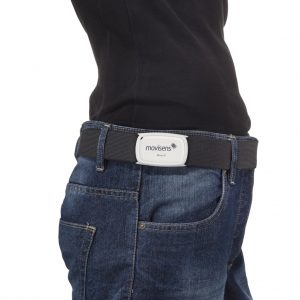Sedentary Behaviour
Sedentary behavior presents one of the 21st century's most pressing health concerns. Whilst the negative side effects of sedentary behavior feature prominently in recent scientific publications, the sheer extent of these negative effects remain largely unexplored due to the difficulty of accurately determining sedentary time. A range of different scenarios can influence the interpretation of sedentary behavior. If you're interested in contributing to the ongoing research into sedentary behavior we provide a range of solutions tailored to specific scenarios.
Recommendations
Suggestions for the valid and reliable measurement of sedentary behavior
Scenario 1: Low physical activity defined as sitting
When the daily routine of the participants consists primarily of sitting, as in the case with the majority of office employees, then measuring the general activity level of the participant should provide a useful measure of sedentary behavior. For these cohorts, the activity sensor sensor Move 4 worn on the hip provides a convenient way to track the activity levels of the participants. However, relying on this alone provides only a rough estimate of actual "sedentary behavior" time.

Scenario 2: The distinction between sitting/lying & standing
To distinguish between sitting/lying and standing remains a constant challenge for researchers. Through a useful refinement available through our analysis algorithms we've made this distinction possible. To take advantage of this feature requires the activity sensor Move 4 worn on the participant's thigh. Through assessing the different angles of the acceleration axes, our analysis software DataAnalyzer can differentiate between sit / lie & stand. However, it is not possible to distinguish between sitting and lying.

Scenario 3: Capture sedentary behavioral changes and the intensity of physical activity
Whilst extend periods of sitting remain the key focus of most research in sedentary behavior, there's also a strong desire from researchers to detemine the level of activity intensity when participants transition out of sedentary periods. To capture data on both the body position and energy expenditure, researchers can attach a Move 4 activity sensor to the participants thigh (sitting / lying vs. standing) and a Move 4 activity sensor on the upper body or hip (standing / sitting vs. lying) to determine energy expenditure.

Scenario 4: Detection of sedentary behavior changes with additional static load
The limitation of accelerometery in isolation bevomes apparent in cohorts when there's a likelihood that the participants undertake activities that incorporate a static load, such as lifting weights or stationary cycling. To combat this, we can use the ECG and activity sensor EcgMove 4 to capture additional data for determining energy expenditure. The combination of a Move 4 activity sensor on the thigh (sit / lie vs. stand) and the ECG and activity sensor EcgMove 4 on the upper body (standing / sitting vs. lying) provides an excellent overview of the activity level of the participant. The addition of the ECG signal enables better estimation of energy expenditure during static activities due to the linear relationship between cardiorespiratory stress and energy expenditure.

Scenario 5: Capturing sitting and staging interventions
Whilst accurately determining sedentary periods remains a worthy goal, assessing the motivations behind the behavior and implementing interventions seems the logical next stage of such research. When investigating the subjective feelings of participants, it's possible to trigger a questionnaire via the SensorTrigger app on our Experience Sampling Platform movisensXS during sedentary periods. Various triggering algorithms use on different physiological changes to prompt the participant to answer a series of questions. The "Sedentary" trigger sends a questionnaire after a determined amount of time in the sitting position (e.g. 30 minutes) elapses. This makes it possible to get more detailed feedback and thus more accurate insights into the everyday life of volunteers. Eventually, after capturing suitable data, the same process can function as an intervention, sending messages to assist in highlighting awareness of the behavior.

Sample study
Sedentary Mood-Study
What influence does Sedentary Behavior have on mood?
Despite recent research, the extent to which sedentary behavior affects mental health remains relatively unknown. However, the few available findings indicate that a connection could exist. "Sitting changes the activity of metabolism and therefore it doesn´t seem absurd, that this can also influence the psychological processes." If the link between sedentary behaviour and adverse psychological health exists, understanding it would prove valuable in the fight against psychosomatic diseases.

Useful information
It's clear that moderate physical activity, including exercise, training and everyday activities, provide many health-level benefits. Recent research suggests that sedentary behavior such as prolonged, uninterrupted sitting poses a health risk. Instead of sitting, even light activity, such as standing and walking reduces that risk.
"Sedentary Behavior, Sedentariness or Sedentary Activity" refers to activity with a MET (Metabolic Equivalent of Task) of less than 1.0 to 1.5. International literature discusses sedentariness as a risk factor that works independently of physical activity. Studies suggest that someone who is occasionally active, but sits continuously for longer periods of time during the rest of the day, endangers his health just as much as the one who is inactive but lingers for less.
In order to assess sedentary behavior in a valid and reliable way, both measurement must include BOTH body position and energy expenditure! The daily duration of sedentary behavior remains the most commonly used measure. However, this fails to distinguish the relevance of different temporal patterns such as short phases vs. long periods. Therefore, we recommend measuring the duration of "non-sedentary behavior" as well as categorising physically active phases in addition to the total duration of sedentary behavior.
Overview activity sensors and their validity
Parameter | Wearing place | Move 4 | ActiGraph | ActiPal |
| Body Position | thigh hip | K=.97 K=.78 | - K=.67 | K=.85 - |
| Sedentary Behaviour | thigh hip | K=.95 K=.84 | - K=.69 | K=.90 - |
Giurgiu M. et al. (2019). Journal for the Measurement of Physical Behaviour.
Literature
Ainsworth, B. E., Haskell, W. L., Hermann, S. D., Meckes, N., Basset Jr., D. R., Tudor-Locke, C.,Leon, A. S. (2011). 2011 Compendium of Physical Activities: a second update of codes and MET values. Med. Sci. Sports Exerc., 43, pp. 1575-1581.
Byrom, B., Stratton, G., McCarthy, M., & Muelhausen, W. (2016). Objective measurement of sedentary behaviour using accelerometers. Int. J. Obes, 40(Lond), pp. 1809-1812.
Carson, V., Wong, S. L., Winkler, E., Hearly, G. N., Colley, R. C., & Tremblay, M. S. (2014). Patterns of sedentary time and cardiometabolic risk among Canadian adults. Prev. Med., 65, pp. 23-27.
Fuchs, R. & Schlicht, W. (2015). Seelische Gesundheit und sportliche Aktivität: Zum Stand der Forschung. In R. Fuchs & W. Schlicht (Hrsg.), Seelische Gesundheit und sportliche Aktivität (S. 1-11). Göttingen: Hogrefe Verlag GmbH & Co. KG.
Holtermann, A., Schellewald, V., Mathiassen, S. E., Gupa, N., Pinder, A., Punakallio, A.,Ellegast, R. (2017). A practical guidance for assessments of sedentary behavior at work: A PEROSH initiative. Applied Ergonomics, 63, pp. 41-52.
SBRN. (2012). Sedentary Behaviour Research Network. Letter to the editor: standardized use of the terms “sedentary” and “sedentary behaviours”. Appl. Physiol. Nutr. Metab., 37, pp. 540-542.